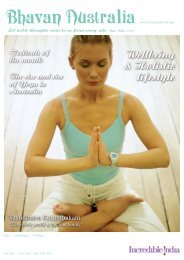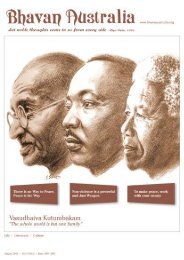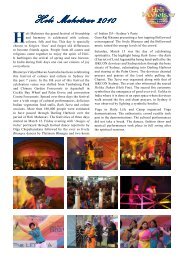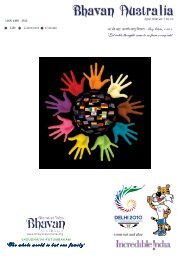Programme Brochure - Bharatiya Vidya Bhavan Australia
Programme Brochure - Bharatiya Vidya Bhavan Australia
Programme Brochure - Bharatiya Vidya Bhavan Australia
Create successful ePaper yourself
Turn your PDF publications into a flip-book with our unique Google optimized e-Paper software.
arrived as an old artist, Ananta Maharana, and promised<br />
that he would carve the Deity form of the Lord inside<br />
the temple in three weeks if the King would allow him<br />
to work behind closed doors. But after 14 days the King<br />
became very anxious because he could no longer hear<br />
the sounds of the carving. Finally he could stand it no<br />
more. On the advice of the queen he personally opened<br />
the doors of the temple to see what was happening. Then<br />
he saw the forms of Lord Jagannatha, Lord Balarama,<br />
and Lady Subhadra. But because the King had opened<br />
the doors sooner than he was supposed to, the Deities<br />
were not completed; Their feet and hands had not yet<br />
been carved. Thus, the Supreme manifested Himself in<br />
this form.<br />
The King felt he had committed a great offense for<br />
having opened the doors before the allotted three<br />
weeks had passed, so he decided to end his life. But<br />
in a dream Lord Jagannatha told the King that though<br />
he had broken his promise, this was just a part of the<br />
Supreme’s pastimes to display this particular form. The<br />
King was told that this form, even though it appeared to<br />
be incomplete, was actually the form of the Lord that<br />
was meant to be worshiped in this age of Kali-yuga.<br />
Occasionally the King could decorate the Deity with<br />
golden hands and feet. Yet those devotees filled with<br />
love would always see the form of Lord Jagannatha as<br />
the threefold bending form of Syamasundara, Krishna,<br />
holding a flute. Thus, the Supreme appeared in this form<br />
so that people could approach and see Him, especially<br />
as He rides through town on the huge carts during the<br />
Ratha-Yatra festival.<br />
The Ratha-Yatra Festival<br />
Ratha-Yatra festival is the most popular time to go to<br />
Jagannatha Puri. Thousands upon thousands of pilgrims<br />
flock to Puri to take part in this auspicious event, which<br />
is said to have been celebrated for thousands of years,<br />
making it one of the oldest and<br />
one of the biggest religious<br />
festivals in the world. This is<br />
the time when the Deities come out of the temple for<br />
all to see. It is also the time when as many as a million<br />
people gather in this small city with one purpose: to<br />
show their faith and devotion to God in the form of<br />
Lord Jagannatha.<br />
The actual construction of the carts begins two months<br />
before the festival day, on the third day of the bright<br />
fortnight of Vaisakha (April–May). More than 600<br />
trees, or 400 cubic meters of wood, are needed for the<br />
construction, taken from the local forests along the<br />
banks of the Mahanadi River. Using the same simple<br />
tools and procedures as they have for the past hundreds<br />
of years, once the basic elements are made, such as the<br />
wheels, then the actual construction begins only a few<br />
weeks before the festival. The construction crew works<br />
on them night and day, and everything gets ready the<br />
day before the festival.<br />
In front of the temple huge stacks of wood are used to<br />
assemble the three chariots which will reach up to three<br />
storeys tall and will roll on wheels, each eight feet high.<br />
The chariots are painted with bright colours and the tops<br />
are covered with red, black, yellow, or green canopies.<br />
The colours signify which chariot is for which Deity.<br />
Lord Jagannatha uses red and yellow, Lord Balarama<br />
uses red and green, while Subhadra uses red and black.<br />
The Deities are also painted with particular colours<br />
that mean something. Jagannatha’s blackish colour<br />
represents faultless qualities; Balarama’s white colour<br />
signifies enlightenment; and Subhadra’s yellow colour<br />
signifies goodness.<br />
Each cart is different. The cart of Lord Jagannatha<br />
is called Cakradhvaja or Nandigosha, which means<br />
tumultuous and blissful sound. Using 16 wheels, it rises<br />
45 feet tall, and weighs 65 tons. It also carries a figure of<br />
Garuda on its crest, and is drawn by four white wooden<br />
horses. Balarama’s cart is called Taladhvaja, meaning<br />
the sound of significantly powerful rhythm. It has 14<br />
wheels, and is drawn by four black wooden horses. It<br />
carries Hanuman on its crest. Subhadra’s cart is called<br />
Padmadhvaja or Darpadalan, which means destroyer of<br />
pride. It has a lotus on its crest, uses 12 wheels, and<br />
is drawn by four red wooden horses. After the Ratha-<br />
Yatra festival the wood from the carts is used as fuel for<br />
the big kitchen in the temple, which can last up to nine<br />
months.<br />
About two weeks before the festival, the Deities of<br />
Jagannatha, Balarama, and Subhadra are given a ritual









